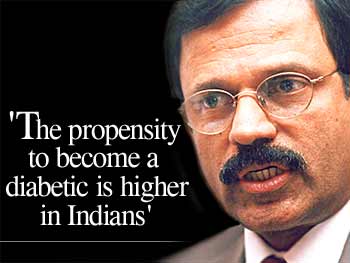
The 4th World Congress on Prevention of Diabetes and its Complications, organised by the World Health Organisation, the Diabetes Research Centre and the M V Hospital for Diabetes in Chennai, the International Diabetes Federation, Belgium and the Centre for Disease control, Atlanta, concluded in Chennai.
The decision to have the World Congress in India was taken by WHO mainly because every fourth diabetic in the world is an Indian. According to WHO projections, the 30 million to 33 million diabetics in India will go up to 40 million by 2010 and 74 million by 2025.
WHO has issued a warning that India will be the Diabetes capital of the world.
Professor A Ramachandran, Head of the Diabetes Research Centre, was chairman of the organising committee of the World Diabetic Congress.
In an interview to rediff.com Special Contributing Correspondent Shobha Warrier, he says Indians, irrespective of where they live, fall under the high risk group, hence they have to try to prevent getting diabetes.
People were made to understand that diabetes was genetically transmitted, and there was no cure for it. Doctors were talking only about management of the disease. Suddenly, you have shifted the mode to prevention. The theme of the World Diabetic Congress was prevention.
Once diabetes occurs, a person's metabolism changes so much that you cannot cure diabetes. Even before you are diagnosed as having diabetes, you have started having the risk of the complications of diabetes. Treating diabetes is a lifelong affair. We have limitations of controlling diabetes to the levels we want because bringing down the blood sugar value to normal is a challenge.
When did the shift from cure to prevention take place? What was the reason behind the change in outlook?
There is an increase in the prevalence of diabetes all over the world. At the same time, we find there is an increase in the risk factors associated with diabetes like obesity, sedentary life habits and stress. We realised the factors can be prevented/controlled.
The question was asked, if you make people work more, walk more and reduce eating and avoid obesity, can you prevent diabetes?
We know there is a way of identifying people with pre-diabetes although the word is not completely agreed upon. The pre-diabetic stage is where the blood sugar is not normal but below the diabetic criteria of diabetes. There are two categories; one is impaired glucose tolerance where the value is between 140 and 199, and the diagnostic value is 200. The other stage is impaired fasting glucose where the fasting value is above 100 and below 126. People who belong to this category have a very high risk of developing diabetes over the years especially if the family has a history of diabetes.
Trials conducted in the US have found that by lifestyle modification and by reducing the weight by seven percent through physical activity, we can reduce the incidence of diabetes by 58 percent. We know that by controlling the risk factors on high risk individuals, you can reduce the prevalence of diabetes.
So, the question is, why not prevent diabetes? That is why there is a big push on primary prevention of diabetes.
You said obesity is considered one of the major risk factors. Why is it that Indians who are thin and lean are more prone to diabetes than the more obese Westerners?
Our genetic susceptibility is more powerful. The propensity to become a diabetic is higher in Indians. We have a low threshold for the risk factors. Americans develop diabetes when the body mass index is 30 and 35. We develop it when the BMI is only 25.
Why do we have a lower threshold?
It is the racial difference. Reports say people in Bangladesh, Sri Lanka, Pakistan, Nepal, Mauritius and Mali share the common prevalence rates and seem to share the susceptibility genes, and the same environmental risk factors. We also share the lowered threshold of conventional risk factors, unfortunately.
Are the risk factors applicable to Indians living anywhere in the world, or only to those who live in India?
It is applicable to all Indians irrespective of the place they live. Some of the worst reports come from South Africa, the United Kingdom and the US. Indians living in South Africa have a higher prevalence of diabetes compared to South Africans and the white population.
A report from London says Indians or South Asians living in London have a higher prevalence of diabetes compared to the white population or the Afro-Caribbean population although they are not more obese than the British.
I wrote and published the first paper from India in the British Medical Journal where I compared the prevalence of diabetes in the urban population in India. It is as high as the prevalence of diabetes for Indians living in Southall in London.
Some good studies have been done among Indians in the US, and it is found that 18 percent Indians living in Atlanta have a prevalence of diabetes, which is higher than the prevalence of diabetes in Indian cities. The prevalence of diabetes in the immigrant population is high, a little higher than what you see in Chennai and Mumbai. The reasons could be, they are under more mental stress. They must be taking high calorie food and there may be less physical activity.
We have indications that Indian immigrants to the US and UK have a high prevalence of not only diabetes but coronary heart disease too.
What precautions should Indians living all over the world take to prevent diabetes?
If you have a family history of diabetes, and if you are a girl, you better start thinking about diabetes prevention at 20 to 25 as during pregnancy, you may test positive for diabetes. If you are a man and obese, you should start thinking about diabetes once you cross 25. If you are not obese, the disease may strike you only after 40. Family history of diabetes is a very important risk factor in all of us.
We have a big problem in hand. The information technology professionals. They are under tremendous stress at work. We used to see many cases of diabetes among doctors and surgeons. Now we have this new class of very young people. They don't follow any timing, they have the pressure of deadlines, they have irregular meals, they work at night and they have only time to sit in front of the computer for hours and hours without any physical exercise.
Similarly, if you take the case of immigrants, who are uncertain of their jobs, especially in the Persian Gulf region, develop diabetes more often.
What we should do to guard is, first, don't gain weight. Be active. More importantly, childhood obesity should be prevented. Obesity in childhood leads to obesity in adulthood.
Health education should start from the school level. Children should not be allowed to take junk food, and should be encouraged to indulge in physical activity.
WHO has announced an awareness program on diabetes like they did for AIDS, tubercolosis, polio. How effective will this awareness campaign be?
It will be very effective. A good example is smoking.
Photograph: Sreeram Selvaraj
Image: Uttam Ghosh






 © 2025
© 2025